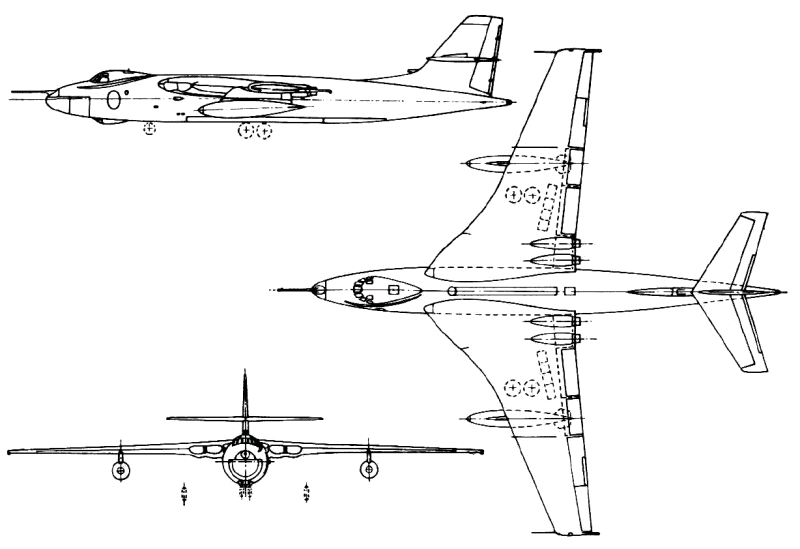- Yes
- No
Hello and welcome to my suggestion for the Handley Page Valiant B.1, the first bomber of the legendary British V–Force. I feel this is a valid suggestion after the recent Advent of the F-111A and given its history alongside the other V–Bombers, the Victor and Vulcan.
History
Spoiler
The Valiants story Begins in 1946 when the RAF Air Staff put out Operational Requirements 229 and 230 for the development of a Turbojet powered Heavy Bomber Capable of Nuclear Deterrent and Strike, alongside this Britain began its development of Domestic Nuclear Weapons.
In 1947 the Air ministry issued Specification B.35/46 for an advanced Jet bomber capable of near supersonic Flight at 15000m and capable of carrying Nuclear weapons. Four companies (Avro, Short, Vickers-Armstrong and Handley-Page) submitted Designs for this, however Shorts Submission was considered too ambitious and was disqualified in the early stages.
Initially Vickers Designed a Six engined Bomber to compete but with rapid advancement in Jet engine technology they redesigned it in favour of a 4 engined version. However whilst Handley-Page and Avro had submitted two competitive Designs, Vickers design was rejected due to it being Judged as less advanced as the Vulcan and Victor Designs. However thanks to intense lobbying by Vickers chief Designer the air ministry Accepted the design on the basis that it would be available sooner than its competitors.
The First Valiant Prototype Made its maiden flight on the 19th of May 1951 as the Vickers Type 660 but after the success of the initial flights was given the name ‘Valiant’. in April the Order was placed for an initial batch of 25 aircraft and on the 8th of February 1955 the first aircraft was delivered to the RAF, over a year before the first Vulcans and Victors would come into service. In total 107 B.1 Airframes were delivered with an additonal one being completed to the Proposed B.2 standard.
alas due to the Valliant’s Changing role from high altitude Bombing to low altitude Strike, the airframe struggled to keep up and by 1964 severe Fatigue was found in the Valliant’s Airframe and due to RAF budget cuts the decision was made to retire the Valliant’s almost 20 years before its V-bomber Brethren.
The Valiant serves as a reminder to the once great Vickers Aircraft manufacturing as it was the last combat aircraft produced by Vickers, with the only other airframe after used by the RAF was the VC.10 as a transport and aerial refueler.
Photos
Spoiler

The Valiant’s Wing root and air intakes

Valiant B.1 dropping Blue Danube Nuclear bomb (Presumably Inert)

Technical Drawing of the Valiant

Valiants at RAF Gaydon in 1956

additional eye Candy
Specs/ armament
Spoiler
General characteristics
- Crew: five – two pilots, two navigators (one navigator plotter + one navigator radar), air electronics officer
- Length: 108 ft 3 in (32.99 m)
- Wingspan: 114 ft 4 in (34.85 m)
- Height: 32 ft 2 in (9.80 m)
- Wing area: 2,362 sq ft (219.4 m2)
- Empty weight: 75,881 lb (34,419 kg)
- Max takeoff weight: 140,000 lb (63,503 kg)
- Powerplant: 4 × Rolls-Royce Avon RA28 Mk 204 turbojets, 10,000 lbf (44 kN) thrust each
Performance
- Maximum speed: 567 mph (912 km/h, 493 kn) at 30,000 ft (9,100 m)
- Range: 4,500 mi (7,200 km, 3,900 nmi) with underwing tanks
- Service ceiling: 54,000 ft (16,000 m)
- Rate of climb: 4,000 ft/min (20 m/s)
Armament
-
Bombs:
- 1× 10,000 lb (4,500 kg) [Blue Danube]nuclear bomb or
- 1× B28 nuclear bomb or
- 21× 1,000 lb (450 kg) bombs
Valiant in game
Spoiler
In game the Valiant would act as a better Canberra with vastly better bomb load, it would not be out of place in the British tree either as it fits in with the trend of slower, Heavy bombers with immense bomb load but very little in the way of self defence.
I would personally put it at either 8.3 or 8.7 after the Canberras as it is the first and weakest of the V-force and would be a logical stepping stone up from the canberras to the more advanced Victors and Vulcans should they also come to game
Sources


